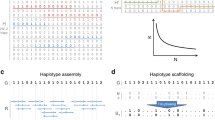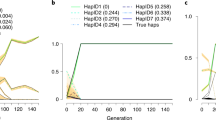Abstract
We introduce HybHap, a new approach for haplotype inference problem on large genotype datasets. HybHap is a hybrid method, based on the Parsimonious tree-grow idea, which resorts to Markov chains, in order to maximize the probability that the haplotypes will be shared by more genotypes in the dataset. Several experiments with large biological datasets taken from HapMap were performed to compare HybHap with two well known algorithms: fastPHASE and PTG. The results show that HybHap is a rather robust, reliable, and efficient method that runs orders of magnitude faster than the others, producing results of comparable accuracy, hence being much more suitable to deal with the challenge of genome wide tasks.
Access this chapter
Tax calculation will be finalised at checkout
Purchases are for personal use only
Preview
Unable to display preview. Download preview PDF.
Similar content being viewed by others
References
Sonis, S., Antin, J., Tedaldi, M., Alterovitz, G.: SNP-based Bayesian networks can predict oral mucositis risk in autologous stem cell transplant recipients. Oral Dis (2013)
Jin, Y., Lee, C.G.L.: Single Nucleotide Polymorphisms Associated with MicroRNA Regulation. Biomolecules 3(2), 287–302 (2013)
Martinez-Herrero, S., Martinez, A.: Cancer protection elicited by a single nucleotide polymorphism close to the adrenomedullin gene. J. Clin. Endocrinol. Metab (2013)
Wang, E.Y., Liang, W.B., Zhang, L.: Association between single-nucleotide polymorphisms in interleukin-12a and risk of chronic obstructive pulmonary disease. DNA Cell Biol. 31(9), 1475–1479 (2012)
Gusfield, D.: Haplotyping as perfect phylogeny: Conceptual framework and efficient solutions. In: International Conference on Research in Computational Molecular Biology (RECOMB), pp. 166–175 (2002)
Rosa, R.S., Guimarães, K.S.: Insights on haplotype inference on large genotype datasets. In: Ferreira, C.E., Miyano, S., Stadler, P.F. (eds.) BSB 2010. LNCS (LNBI), vol. 6268, pp. 47–58. Springer, Heidelberg (2010)
Ding, Z., Filkov, V., Gusfield, D.: A linear-time algorithm for the perfect phylogeny haplotyping (PPH) problem. In: Miyano, S., Mesirov, J., Kasif, S., Istrail, S., Pevzner, P.A., Waterman, M. (eds.) RECOMB 2005. LNCS (LNBI), vol. 3500, pp. 585–600. Springer, Heidelberg (2005)
Gusfield, D.: Inference of haplotypes from samples of diploids populations: Complexity and algorithms. Journal of Computational Biology 8, 305–324 (2001)
Gusfield, D.: Haplotype inference by pure parsimony. In: Baeza-Yates, R., Chávez, E., Crochemore, M. (eds.) CPM 2003. LNCS, vol. 2676, pp. 144–155. Springer, Heidelberg (2003)
Lancia, G., Pinotti, M.C., Rizzi, R.: Haplotyping populations by pure parsimony: Complex of exact and approximation algorithms. INFORMS J. Computing 16, 348–359 (2004)
Halldórsson, B.V., Bafna, V., Edwards, N., Lippert, R., Yooseph, S., Istrail, S.: A survey of computational methods for determining haplotypes. In: Istrail, S., Waterman, M.S., Clark, A. (eds.) DIMACS/RECOMB Satellite Workshop 2002. LNCS (LNBI), vol. 2983, pp. 26–47. Springer, Heidelberg (2004)
Brown, D.G., Harrower, I.M.: Integer programming approaches to haplotype inference by pure parsimony. IEEE/ACM Trans. Comput. Biol. Bioinformatics, pp. 141–154 (2006)
Li, Z., Zhou, W., Zhang, X., Chen, L.: A parsimonious tree-grow method for haplotype inference. Oxford Bioinformatics 21, 3475–3481 (2005)
Sun, S., Greenwood, C.M., Neal, R.M.: Haplotype inference using a bayesian hidden markov model. Genetic Epidemiology 31, 937–948 (2007)
Zhang, J.H., Wu, L.Y., Chen, J., Zhang, X.S.: A fast haplotype inference method for large population genotype data. Computational Statistics and Data Analysis 52, 4891–4902 (2008)
Eronen, L., Geerts, F., Toivonen, H.: Haplorec: efficient and accurate large-scale reconstruction of haplotypes. BMC Bioinformatics 7, 542 (2006)
Eronen, L., Geerts, F., Toivonen, H.: A markov chain approach to reconstruction of long haplotypes. In: Pacific Symposium on Biocomputing, pp. 104–115 (2004)
Stephens, M., Smith, N.J., Donnelly, P.: A new statistical method for haplotype reconstruction from population data. American Journal of Human Genetics 68, 59–62 (2001)
Scheet, P., Stephens, M.: A fast and flexible statistical model for large-scale population genotype data: applications to inferring missing genotypes and haplotypic phase. American Journal of Human Genetics 78, 629–644 (2006)
The International HapMap Consortium: The international hapmap project. Nature 426, 789–796 (2003)
Niu, T., Qin, Z.S., Xu, X., Liu, J.S.: Bayesian haplotype inference for multiple linked single-nucleotide polymorphism. American Journal of Human Genetics 70, 157–169 (2002)
Author information
Authors and Affiliations
Editor information
Editors and Affiliations
Rights and permissions
Copyright information
© 2013 Springer International Publishing Switzerland
About this paper
Cite this paper
Rosa, R.S., Guimarães, K.S. (2013). HybHap: A Fast and Accurate Hybrid Approach for Haplotype Inference on Large Datasets. In: Setubal, J.C., Almeida, N.F. (eds) Advances in Bioinformatics and Computational Biology. BSB 2013. Lecture Notes in Computer Science(), vol 8213. Springer, Cham. https://doi.org/10.1007/978-3-319-02624-4_3
Download citation
DOI: https://doi.org/10.1007/978-3-319-02624-4_3
Publisher Name: Springer, Cham
Print ISBN: 978-3-319-02623-7
Online ISBN: 978-3-319-02624-4
eBook Packages: Computer ScienceComputer Science (R0)




